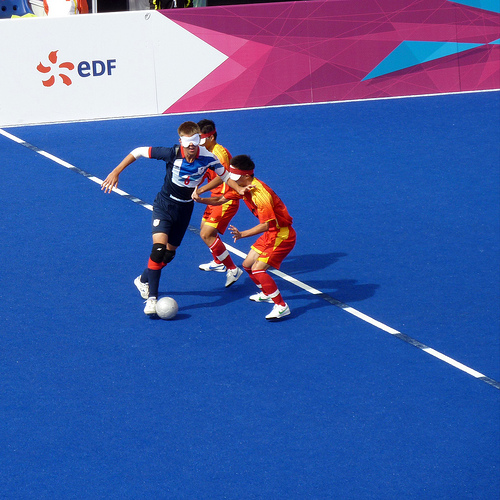By Jessica Wind (Contributor) – Email
Print Edition: September 19, 2012
On September 8, in London, Brazil’s national men’s visually impaired football team collected the gold medal for five-a-side blind football. France took home the silver medal and Spain defeated Argentina for the bronze. It was awesome and ultimately humbling to watch these athletes compete for Olympic glory. This football variation made its first debut in Athens in 2004 and is played by athletes with visual impairments of varying degrees. This year in London, 94 athletes were looking for the podium.
Five-a-side, or blind soccer, is played much like sighted soccer, with only a few necessary modifications. Players (except the keeper) wear blackout masks to ensure fairness, and there are guides behind each net to direct the opposition. Unlike other soccer fields, the five-a-side field is smaller and has dasher boards along the sidelines to keep the ball in constant play.
Still, to this reporter it seemed like an impossible challenge. As I watched the players maneuver down the field, I wondered how they didn’t simply run over the ball and into each other. The ball itself has been modified with ball bearings to make it audible, and the three guides (the keeper in the defensive third, the coach on in the middle third and the guide behind the net in the offensive third) communicate constantly as play moves around the field. In the event of a free kick, the opposing guide bangs on the goal posts, so the kicker knows exactly where to place the ball. To put the ball into play, a player lines up with his feet on either side of the ball, and a teammate standing behind him places his foot on the ball. When the whistle blows, the teammate removes his foot and the player standing over the ball takes possession (this method is in line with FIFA official rules and is not unlike the pass used to begin play in sighted soccer). Game play is fast-paced and detailed, with players making more quick movements to dart around their opposition rather than relying on big crosses or lengthy dashes down field. As a player dribbles, he keeps the ball less than a foot in front of him at all times, with each step forward including a slight tap on the ball to move it forward. Players are constantly aware of where the ball is in relation to their feet. The sighted keepers are confined to their own box, making saving the ball harder than if they were allowed to move freely as in regular 11-a-side soccer. Without the ability to see the ball and the field in front of them, players rely far more on their space perception and communication to successfully find the back of the net.
Naturally, after doing my research, I had to test it out. I am no stranger to the sport of soccer, but have always been fortunate enough to see the ball at my feet, and anything that might be in my way. With a blindfold securely over my eyes, sufficiently disorienting me, I attempted to dribble down the hallway. After bumping into the wall and groping the air with my foot in attempt to find the ball that was always just barely to my right, I can confidently say, blind athletes are incredibly talented.


